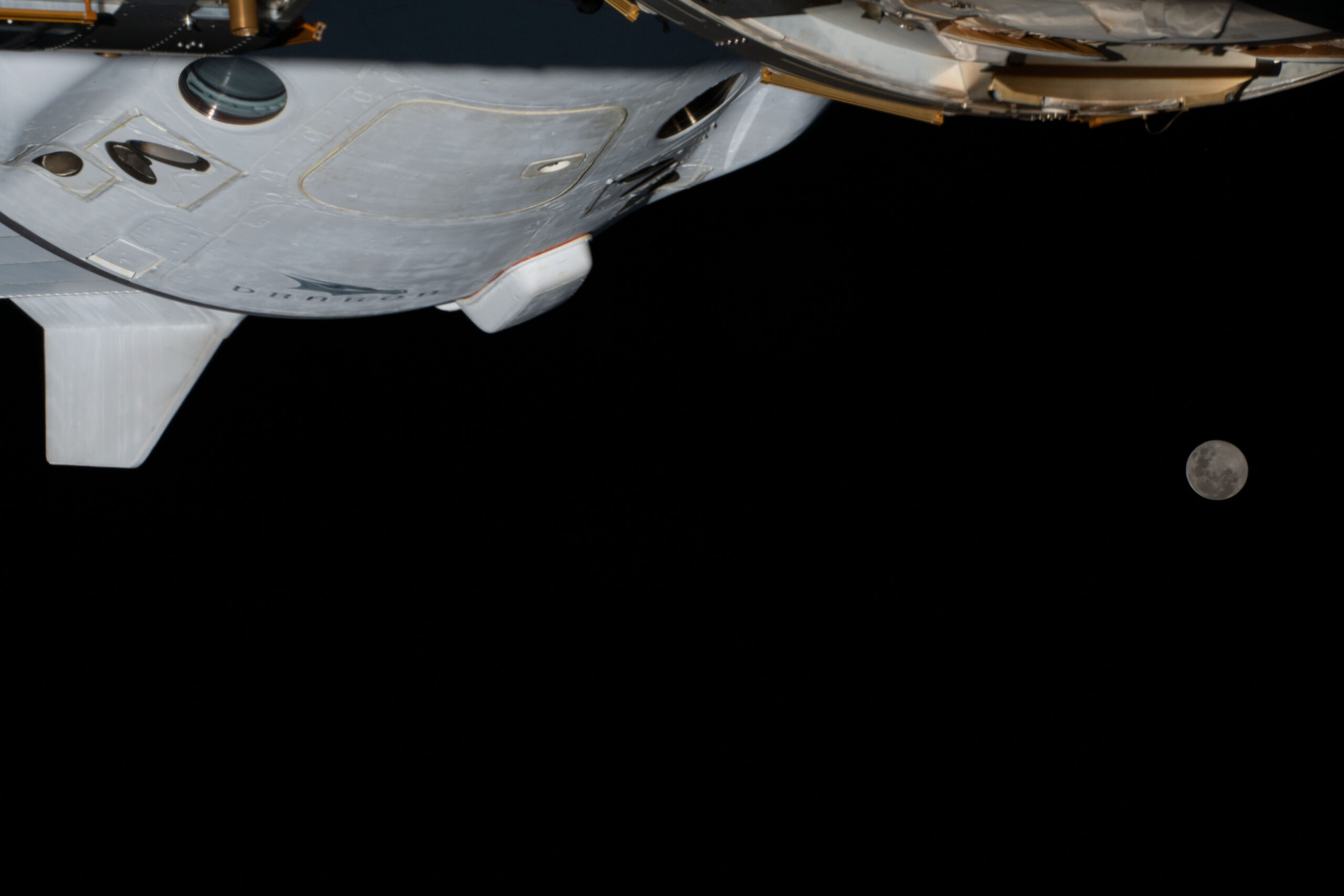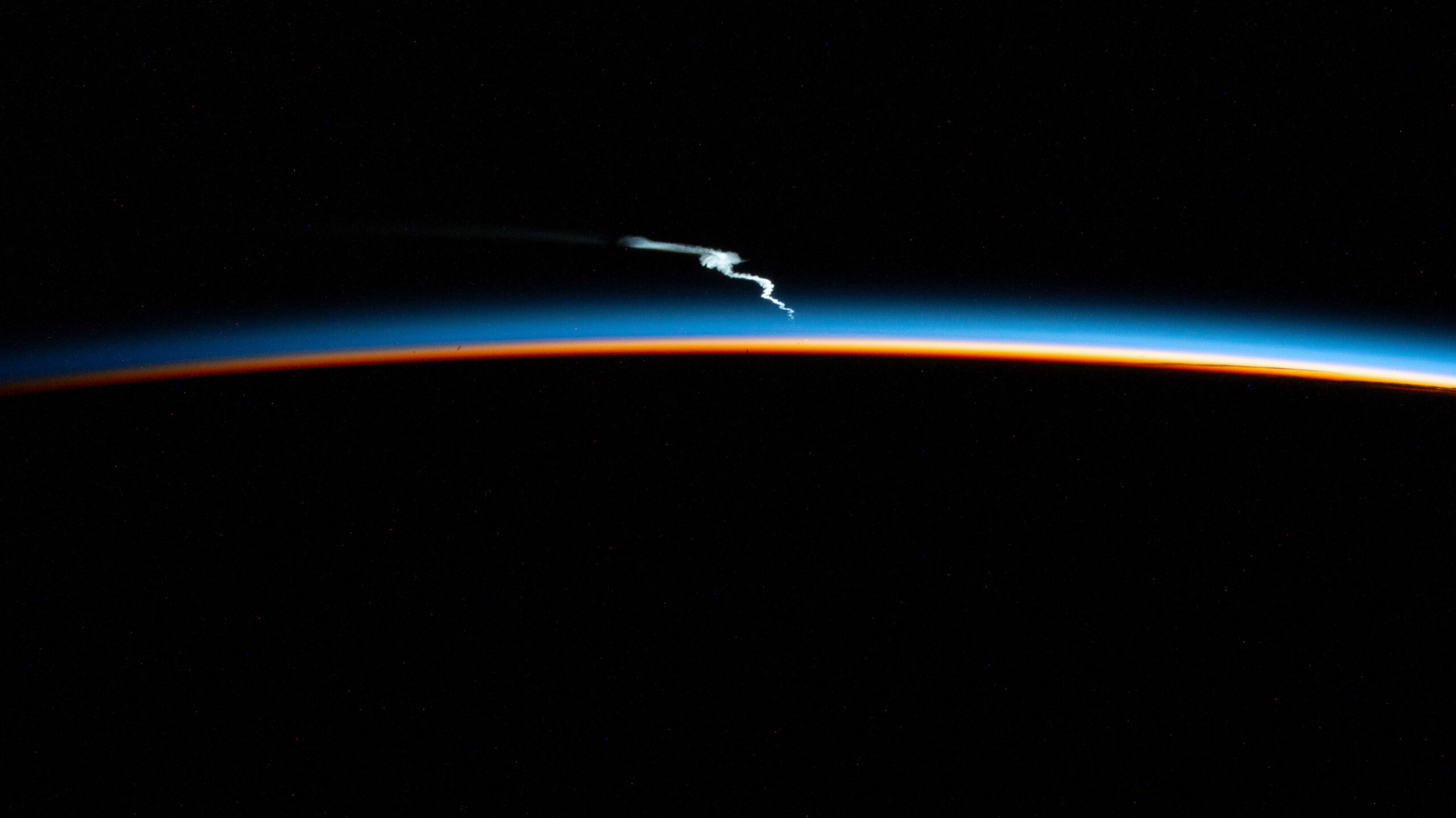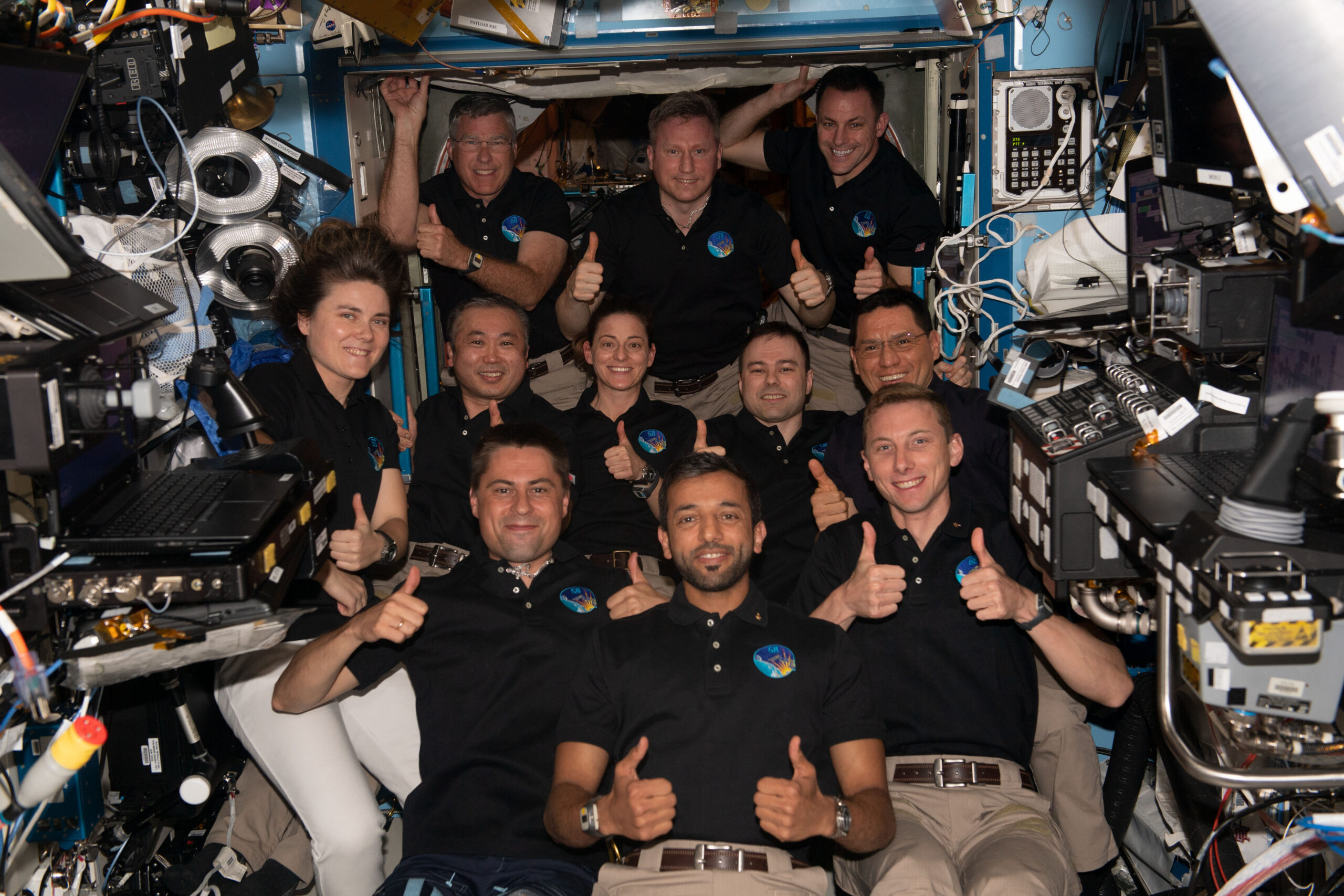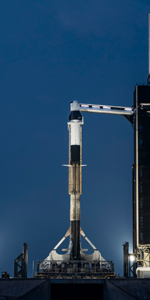
After five months aboard the International Space Station (ISS), Crew-5 safely returned to Earth on Saturday, wrapping up over 157 days in space, some 2,512 Earth orbits, 66.5 million miles (107 million kilometers) traveled, hundreds of research investigations and five sessions of Extravehicular Activity (EVA), totaling more than 35 hours. Commander Nicole Mann and Pilot Josh Cassada of NASA, together with Mission Specialists Koichi Wakata of the Japan Aerospace Exploration Agency (JAXA) and Anna Kikina of Roscosmos, splashed down off the Florida Coast at 9:02 p.m. EST Saturday, their good ship Dragon Endurance staking a well-earned claim in the record books as SpaceX’s most-flown Crew Dragon to date.
With two long-duration ISS expeditions to her credit, Endurance—which also supported the 176-day Crew-3 increment to the station between November 2021 and May of last year—has now logged more than 330 days in space. In doing so, she eclipses her sister Endeavour, currently on-orbit and enjoying the opening days of her fourth flight.
But by the time Endeavour returns to Earth in late August, she will snatch back this record. And that will likely see Endeavour become the first Crew Dragon to log more than a cumulative year in orbit.

Crew-5’s story began in October 2021, when Mann and Cassada—the last two unflown members of NASA’s 2013 astronaut class—were reassigned to command and pilot the mission. Both had previously trained to fly Boeing’s CST-100 Starliner.
But with Starliner having endured a troubled maiden voyage in December 2019, followed by additional delays which pushed its second uncrewed test flight deep into the late spring of 2022 and its first crewed mission even further to the right, NASA opted to reassign the pair to Crew-5. The stated rationale was to give them an earlier opportunity to gain spaceflight experience.

Wakata, by complete contrast, was a seasoned veteran, having flown three Space Shuttle missions between January 1996 and July 2009 and once aboard Russia’s Soyuz spacecraft. During this time, he logged a pair of long-duration stays on the ISS and more than 347 cumulative days in orbit.
And for two months in early 2014, Wakata served as the first Japanese commander of the station, prior to his assignment to join Crew-5 in the fall of 2021. But Crew-5’s fourth position remained unfilled until last summer, when a long-awaited integrated crew agreement between NASA and Roscosmos was finally signed.

Under its language, the agreement is designed to ensure that at least one U.S. astronaut flies on each Russian Soyuz and at least one Russian cosmonaut flies on each Commercial Crew vehicle. This will maintain an unbroken presence of U.S. Operational Segment (USOS) and Russian Orbital Segment (ROS) crew in the event of launch delays or the premature return to Earth of one or more of the partners’ vehicles.
Assigned to the fourth seat aboard Dragon Endurance was Anna Kikina, the first Russian cosmonaut to launch aboard a U.S. spacecraft since November 2002 and only the sixth of her countrywomen ever to travel into space. Crew-5 was targeted to fly early last September, but met with more than a month of delay.

This occurred in part due to minor damage incurred by her Falcon 9 booster’s first stage, which hit a road bridge during its transit from the SpaceX factory in Hawthorne, Calif., to the Rocket Development Facility in McGregor, Texas. Additionally, to create “schedule deconfliction” and better spacing following the return of an earlier crew—and in response to the ravages of Hurricane Ian late last September—launch slipped into the early part of the following month.
Aboard Dragon Endurance, Mann, Cassada, Wakata and Kikina launched from historic Pad 39A at Florida’s Kennedy Space Center (KSC) at 12:00:57 p.m. EDT on 5 October. Their brand-new Falcon 9 booster pushed them smoothly uphill and into low-Earth orbit.

Following a 29-hour rendezvous profile, Dragon Endurance docked autonomously at the forward port of the space station’s Harmony node at 5:01 p.m. EDT on 6 October. At the instant of physical docking, the two spacecraft were flying 258 miles (415 kilometers) over the west coast of Africa.
Hatches into the sprawling orbital complex were opened at 6:49 p.m. EDT. The newcomers were welcomed by Expedition 68 Commander Samantha Cristoforetti of Italy, her U.S. crewmates Kjell Lindgren, Bob “Farmer” Hines, Jessica Watkins and Frank Rubio and Russian cosmonauts Sergei Prokopyev and Dmitri Petelin.

During the televised welcoming ceremony, Mann and Cassada were delighted when Cristoforetti gifted them a couple of black-and-white billiard balls. The gift thus recognized the last two members of NASA’s 2013 astronaut intake (whose class nickname is “8-Balls”) to reach space.
The combined 11-strong crew worked together for a little more than a week, before Cristoforetti formally relinquished command of the ISS to Prokopyev on 12 October. Two days later, after several weather-related wave-offs, Lindgren, Hines, Watkins and Cristoforetti boarded their Dragon Freedom ship, undocked from the station and returned to Earth, splashing down off the Florida Coast to conclude 170 days in space.

With Expedition 68 returned to nominal seven-person operations, under Prokopyev’s command, several busy months in support of around 250 scientific investigations lay ahead. Research focuses ranged from modeling how the human brain adapts to microgravity to growing dwarf tomato plants.
Elsewhere, the astronauts and cosmonauts undertook hearing tests and ultrasound eye scans to 3D-printing of organ-like tissues and from understanding central nervous system behavior through analysis of microscopic worms to novel concepts for bone-healing technologies. Other experiments included trials of an ultra-high-definition video camera, studies of atmospheric “airglow” at near-ultraviolet wavelengths, methodologies to pilot future space vehicles and efforts to comprehend the physics of fluid exposed to magnetic and electrical fields.

A cluster of Extravehicular Activity (EVA)—both from the U.S. Operational Segment (USOS) and the Russian Operational Segment (ROS)—were also planned. Five spacewalks were executed by Cassada, Rubio, Wakata and Mann and one by Prokopyev and Petelin.
The ramp-up of U.S. EVAs began in October, when NASA declared itself ready to resume nominal spacewalk operations. This followed “a thin layer of moisture” found inside the helmet of German spacewalker Matthias Maurer in March 2022.

The cause was ultimately attributed to integrated system performance and a number of variables, including crew exertion and cooling settings, which prompted the updating of several operational procedures and mitigation strategies. From late October, the USOS crew began configuring the Quest airlock and their suits for an anticipated trio of EVAs in the November-December timeframe to outfit the station with and a third and fourth set of Boeing-built ISS Roll-Out Solar Arrays (iROSAs).
On 15 November, Cassada and Rubio spent seven hours and 11 minutes outside the ISS, fitting a modification kit onto the starboard-side S-6 truss segment to prepare for the installation of a new array to augment Power Channel 1B. The kit had arrived a week earlier aboard Northrop Grumman Corp.’s NG-18 Cygnus cargo ship.

In the meantime, in late November SpaceX’s CRS-26 Cargo Dragon arrived at the space station, carrying among its 7,700-pound (3,500-kilogram) haul of payloads, supplies and equipment the third and fourth iROSA arrays. These were robotically extracted from the cargo ship’s unpressurized “trunk” by means of the 57.7-foot-long (17.6-meter) Canadarm2 robotic arm on the 29th and temporarily emplaced onto the station’s expansive truss to await another pair of U.S. EVAs to install them.
On 3 December, Cassada and Rubio were outside for their second spacewalk, which ran to seven hours and five minutes and saw them successfully install one of the arrays to augment Power Channel 3A on the starboard-side S-4 truss. The astronauts also disconnected a cable to allow Power Channel 1B to be reactivated following an earlier electrical trip.

Elsewhere, on 17 November Prokopyev and Petelin spent six hours and 25 minutes outside the station, continuing a multi-EVA campaign to outfit Russia’s newest pressurized research module, the Nauka science lab. The duo readied a radiator on the Rassvet module for transfer over to Nauka.
It was then anticipated that three further ROS spacewalks would occur between late November and late December. These were tasked with moving and deploying the radiator, establishing electrical and hydraulic connections and transferring Rassvet’s airlock module to its eventual location aboard Nauka.

But the best-laid plans, as Robert Burns once wrote, and which John Steinbeck later immortalized in Of Mice and Men, often go awry. The cosmonauts’ second EVA on 25 November was canceled due to an issue with a water coolant pump in Prokopyev’s suit and rescheduled for 14 December.
All that came to nought at 7:45 p.m. EST, just as the two men were about to venture outside, when ground personnel observed “significant” leakage from the aft segment of the Soyuz MS-22 spacecraft. Prokopyev and Petelin’s spacewalk was scrubbed as engineers identified a coolant loop leak in the spacecraft’s external radiator.

Temperatures and humidity levels inside Soyuz MS-22 remained within acceptable limits and Canadarm2 inspections on 18 December revealed a small hole and discoloration on the radiator’s surface, suggestive of a Micrometeoroid Orbital Debris (MMOD) impact. Russian engineers also executed a satisfactory test of the spacecraft’s thrusters.
But it was readily apparent as the New Year began that Soyuz MS-22 was no longer viable for the “nominal” return of Prokopyev, Petelin and Rubio, originally scheduled for late March. In mid-January, NASA and Roscosmos determined that a “replacement” ship, Soyuz MS-23, would launch uncrewed in late February and the ISS stay-time of Prokopyev, Petelin and Rubio would be correspondingly extended to as long as a full year.

To facilitate an enhanced “lifeboat” capability, Rubio’s seat liner was transferred as a precautionary measure from Soyuz MS-22 over to Dragon Endurance on 17-18 January. It was planned that it would be installed—along with Prokopyev and Petelin’s seat liners—aboard Soyuz MS-23 following its arrival.
The replacement crew vehicle launched from Kazakhstan’s Baikonur Cosmodrome on 23 February and docked autonomously at the ISS two days later. In addition to its three empty crew places, Soyuz MS-23 carried 946 pounds (429 kilograms) of payloads and supplies for Expedition 68.

By this time, three more U.S. EVAs had continued the iROSA work. On 21 December, Rubio and Cassada were minutes away from heading out of the Quest airlock, when their third EVA was postponed by a Pre-Determined Debris Avoidance Maneuver (PDAM) to create a safe separation distance from a fragment of a Russian Fregat-SB rocket upper stage.
This was the second PDAM to have impacted Expedition 68. Last 24 October, another maneuver was executed to avoid a fragment of Russia’s Cosmos 1408 satellite.

Delayed by 24 hours, Rubio and Cassada were back outside on 22 December. They spent seven hours and eight minutes installing the iROSA array for Power Channel 4A onto the station’s port-side P-4 truss.
With this work complete, four of a total of six iROSA arrays have now been fitted. The final pair are set to arrive aboard SpaceX’s CRS-28 Cargo Dragon in June 2023 for installation later this summer.

In readiness for those final iROSA sets, on 20 January and 2 February the final U.S. EVAs of Expedition 68 were completed, both executed with aplomb and finesse by Wakata and Mann. The first spacewalk, lasting seven hours and 21 minutes, saw them install a modification kit for Power Channel 1B on the station’s S-6 truss.
And the second spacewalk, which ran to six hours and 41 minutes, saw them add an identical kit for Power Channel 1A on the S-4 truss. During their second EVA, Mann and Wakata also labored to relocate an Articulating Portable Foot Restraint (APFR) from the station’s P-6 truss.

Aside from science and spacewalks, Expedition 68 has welcomed or bidden farewell to a flotilla of five uncrewed cargo vehicles, beginning with Progress MS-19 which departed last October. A few days after its undocking, Progress MS-21 arrived for a four-month stay, followed by Progress MS-22 in the second week of February.
Added to the list have been SpaceX’s CRS-26 Cargo Dragon, which launched in late November and departed in early January. And Northrop Grumman’s NG-18 Cygnus, named in honor of America’s first female astronaut, Sally Ride, has been aboard since November.

Despite delivering and removing a substantial quantity of cargo, not all of those resupply missions ran smoothly. Shortly after arriving in orbit, only one of Cygnus’ two fan-shaped solar arrays unfurled, although teams elected not to attempt to deploy the other as sufficient power remained available to execute a satisfactory arrival at the ISS.
And just last month, Russia’s Progress MS-21 exhibited a worrisome issue with its own coolant loop. The cargo ship was only a week away from departure and when it finally undocked on 17 February, Prokopyev and Petelin made visual inspections of the leak as it drifted away into the inky blackness. Progress MS-21 was deorbited over the Pacific Ocean the following day.

By this point, Crew-5’s time aboard the ISS was entering its homestretch, with Crew-6—composed of NASA astronauts Steve Bowen and Warren “Woody” Hoburg, together with Russian cosmonaut Andrei Fedyayev and Sultan Al-Neyadi of the United Arab Emirates (UAE)—launching on their second attempt on 2 March. Following their arrival at the space station aboard Dragon Endeavour in the wee hours of 3 March, the Expedition 68 crew was temporarily boosted to 11 members from four nations.
Hopes of bringing Mann, Cassada, Wakata and Kikina home early Thursday, 9 March proved fruitless, due to anticipated high winds at the targeted splashdown sites off the Florida Coast. Dragon Endurance’s undocking was initially rescheduled for no sooner than Thursday evening, before NASA and SpaceX eventually aimed for a departure early Saturday morning and splashdown at 9:02 p.m. EST the following night.
Hatches between the station and the Crew Dragon closed for the final time at 12:29 a.m. EST Saturday and the two ships parted company at 2:20 a.m. EST. Dragon Endurance completed four separation “burns” as it drifted away from the ISS, heading for a splashdown off the Florida Coast, near Tampa.
Saturday night’s successful splashdown wraps up the Crew-5 mission after 157 days, ten hours and a single minute, 66.5 million miles (107 million kilometers) traveled and 2,512 Earth orbits completed. Winds at the splashdown location were calm, averaging 4 mph (6.4 km/h), with waves around 1-2 feet (30-60 centimeters).

For her part, Dragon Endurance has now spent a cumulative 333 days, 12 hours and 40 minutes in flight, across her two missions. She now heads into post-flight servicing and preparation for her next space voyage, Crew-7, targeted for later this summer.
That mission will see U.S. astronaut Jasmin Moghbeli, Denmark’s Andreas Mogensen, Satoshi Furukawa of Japan and Russian cosmonaut Konstantin Borisov head to the ISS for the six-month Expedition 69/70 increment. During that increment, Mogensen will become the first Dane to command a station crew.

With Crew-5 complete, Koichi Wakata—who wraps up his third long-duration ISS stay—has secured a place as Japan’s most experienced astronaut. He becomes the first non-Russian and non-American to log more than a cumulative 500 days in orbit.
And Nicole Mann, who became the first Native American female spacefarer, has secured personal records as the first woman in history to command a crew on her very first spaceflight. She is also the first female to lead a Commercial Crew vehicle.






8 Comments
8 Pings & Trackbacks
Pingback:SpaceX Crew-5 Successfully Completes 157-Day Mission - Science News
Pingback:Vandenberg Launches Resume, As SpaceX Prepares for Friday Double-Header - AmericaSpace
Pingback:SpaceX Launches CRS-28 Cargo Ship to Space Station - AmericaSpace
Pingback:“You’re Not In A Simulator”: Remembering the Ride of Sally Ride & the Achievements of Women in Space - AmericaSpace
Pingback:At T-1 Month, Multi-National Crew-7 Readies for 15 August Space Station Launch - AmericaSpace
Pingback:SpaceX Begins August, Reflects on Quarter-Millennium of Launches - AmericaSpace
Pingback:SpaceX Targets 12 months’s fiftieth Falcon 9 Launch Tonight - technewscombomber.in
Pingback:SpaceX Targets Back-to-Back Falcon 9 Launches Tonight - AmericaSpace